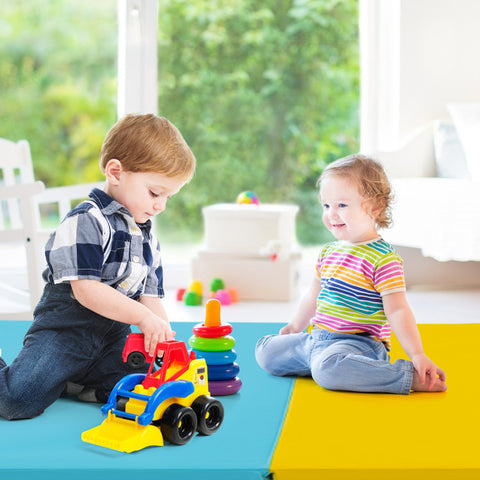News
Understanding Foam Density in Gymnastics Mats: The Key to Safety and Performance
When it comes to gymnastics mats, not all are created equal — and one of the most important factors determining their quality and functionality is foam density. This characteristic defines how firm or soft a mat feels, how well it absorbs impact, and how long it lasts under regular use.
Whether used for professional training, recreational tumbling, or physical therapy, understanding foam density helps athletes and coaches select the perfect balance between comfort, safety, and durability.
What Is Foam Density?
Foam density refers to the mass of foam material per cubic foot (measured in lbs/ft³). It essentially indicates how much material is packed into a given space.
- High-density foam contains more material, making it firm, supportive, and durable.
- Low-density foam has more air pockets, resulting in a softer, more cushioned feel.
Density doesn’t just affect comfort — it determines how effectively the mat absorbs impact energy and protects the gymnast’s body during landings.
The Role of Foam Density in Gymnastics Mats
Foam density impacts several critical aspects of mat performance:
- Shock Absorption: Denser foams disperse impact forces more evenly, reducing strain on joints and muscles.
- Stability: High-density mats provide a stable base for complex movements and flips.
- Durability: Firmer foam retains its structure longer, preventing sagging or uneven surfaces.
- Rebound: Medium-density foam offers better “spring-back,” helping gymnasts transition smoothly between movements.
In short, foam density dictates how the mat responds to movement — too soft, and it may cause imbalance; too firm, and it may feel unforgiving on landings.
Types of Foam Used in Gymnastics Mats
Different types of foam materials are used to achieve varying levels of density and performance:
- Polyethylene (PE) Foam: High-density and closed-cell, offering excellent shock absorption and stability. Ideal for professional or competition-grade mats.
- Polyurethane (PU) Foam: Medium-density and open-cell, providing more cushioning and flexibility for beginner or light tumbling mats.
- EVA Foam (Ethylene Vinyl Acetate): Lightweight with medium-to-high density, balancing comfort and resilience. Common in foldable or portable mats.
Each foam type has unique benefits depending on training intensity and user age.
The Balance Between Comfort and Support
Choosing the right foam density is about finding the balance between comfort and support.
- Soft/Low-Density Foam (1.5–2.5 lbs/ft³):
Suitable for stretching, yoga, and children’s gymnastics. Offers comfort but less stability.
- Medium-Density Foam (2.8–3.5 lbs/ft³):
Ideal for general gymnastics training and home practice. Provides a mix of cushioning and firmness.
- High-Density Foam (4.0–6.0 lbs/ft³):
Designed for advanced tumbling, vaulting, or high-impact routines where stability and safety are paramount.
Selecting the correct density ensures that the mat performs optimally for its intended purpose.
How Foam Density Affects Injury Prevention
Proper foam density is directly tied to injury prevention. Mats that are too soft may bottom out — allowing the body to hit the hard floor underneath — while overly firm mats fail to absorb enough shock.
Benefits of appropriate density include:
- Reduced joint and ligament stress.
- Fewer impact-related injuries.
- Improved balance and control during landings.
- Enhanced energy transfer for performance consistency.
Athletes who train regularly rely on consistent foam quality to maintain technique and confidence.
How Manufacturers Test Foam Density
Foam density testing involves measuring the mass-to-volume ratio and assessing how the material performs under load. Key metrics include:
- Compression resistance: How much pressure the foam can handle before deforming.
- Tensile strength: The foam’s ability to stretch without tearing.
- Resilience index: How quickly the foam returns to its original shape after impact.
These standardized tests ensure that each mat meets international safety and performance benchmarks.
Signs Your Gymnastics Mat Foam Density Has Degraded
Even premium mats can lose density over time. Common signs include:
- Visible sagging or uneven surfaces.
- Reduced rebound or delayed recovery after pressure.
- Hard spots or thin areas in high-use zones.
- Feeling of the floor beneath during landings.
When these signs appear, it’s time to replace or refoam your mat to maintain safety and performance.
Maintenance Tips to Preserve Foam Integrity
To extend the lifespan of your gymnastics mat:
- Store flat and avoid rolling for long periods.
- Keep away from heat and humidity to prevent foam breakdown.
- Clean with mild soap — harsh chemicals weaken foam cells.
- Avoid heavy equipment pressure when not in use.
Proper care helps maintain density consistency and prolongs the mat’s structural performance.
Conclusion
Foam density is more than a technical detail — it’s the foundation of performance, comfort, and safety in gymnastics mats. Understanding how density affects impact absorption, rebound, and durability helps athletes and coaches make smarter equipment choices.
A well-balanced foam density ensures gymnasts can train with confidence, minimize injuries, and enjoy long-lasting mat performance. In essence, it’s not just about how soft or firm a mat feels — it’s about how well it supports every landing.
FAQs
1. What is the ideal foam density for beginner gymnasts?
Medium-density foam (2.8–3.5 lbs/ft³) provides the right balance of comfort and stability for safe beginner training.
2. Can foam density affect the mat’s lifespan?
Yes. Higher-density foam tends to last longer and resist compression compared to low-density foam.
3. Is higher foam density always better?
Not always. While high density offers more support, it can be too firm for light or low-impact exercises.
4. How often should gymnastics mats be replaced?
Typically every 3–5 years, depending on usage intensity and foam quality.
5. Can I mix mats of different densities in one training area?
Yes, but it’s best to match mat densities for uniform performance, especially in tumbling zones.


